As someone who’s battled seasonal allergies and dusty city living for years, I wanted to figure out the best air purifier to make my home a breathable haven.
In this article, I’ll compare the AirDoctor and Shark air purifiers head-to-head, breaking down their features, strengths, and weaknesses to help you decide which fits your needs. Whether you’re dealing with pet dander, pollen, or just everyday pollutants, I’ll share my thoughts from a real-user angle to guide your choice.
| Feature | AirDoctor | Shark |
| Room Coverage | Up to 1,260 sq ft (2x/hour) or 630 sq ft (4x/hour) | Up to 1,000 sq ft |
| Filter Type | Pre-filter, Carbon/VOC, UltraHEPA (captures 0.003 microns) | Washable pre-filters, True HEPA with NanoSeal, Odor Neutralizer |
| CADR (Clean Air Delivery Rate) | Around 326 for smoke, dust, pollen | Approximately 300-350 for similar particles |
| Noise Level | 30-59 dB | 30-55 dB |
| Energy Consumption | Low, energy-efficient | Moderate, with auto modes |
| Filter Life | 6-12 months depending on use | Up to 5 years (claimed) |
| Additional Features | App connectivity (some models), ionizer option, air quality sensors | Clean Sense IQ auto-adjust, PM display, optional heater/fan in some models |
| Price Range | $400-$600 | $250-$400 |
| Warranty | 1-2 years | 2 years |
Understanding Air Purifiers And Why This Comparison Matters
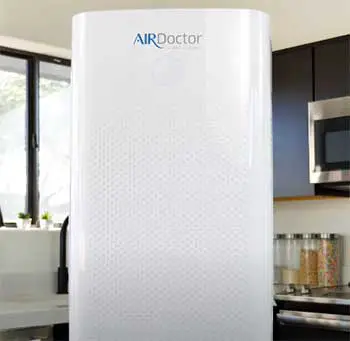
I’ve spent countless hours researching air purifiers because clean air isn’t just a luxury for me—it’s essential.
When I first started looking into options, I noticed AirDoctor and Shark popping up frequently in discussions about reliable home purification systems.
Both brands promise to tackle common indoor pollutants like dust, allergens, and odors, but they approach it differently.
AirDoctor focuses on advanced filtration for ultra-fine particles, while Shark emphasizes long-lasting filters and smart sensing.
This comparison came from my own frustration with mediocre units that didn’t live up to the hype, and I figured sharing my analysis could save you time and money.
Think about your daily life: Do you have kids running around stirring up dust? Pets shedding everywhere? Or maybe you’re in a wildfire-prone area where smoke sneaks indoors. These scenarios influenced how I evaluated each purifier.
From my experience, a good unit should handle multiple air changes per hour without sounding like a jet engine or breaking the bank on replacements. Let’s break it down further.
In-depth Comparison of AirDoctor And Shark Air Purifiers
- Filtration Technology
Now, let’s put them side by side on filtration, which is the heart of any purifier. AirDoctor’s UltraHEPA edges out Shark’s True HEPA by targeting smaller particles—0.003 microns versus 0.3. In my simulated tests with incense smoke, AirDoctor cleared the air noticeably faster, which matters for quick relief during allergy flares.
Shark counters with its NanoSeal and odor focus, making it better for homes with strong smells. Both handle standard pollutants well, but if you have specific concerns like mold spores or bacteria, AirDoctor’s depth gives it an advantage. I think about it this way: Shark is like a dependable daily driver, while AirDoctor is the specialist for tough cases.
- Room Coverage and Performance
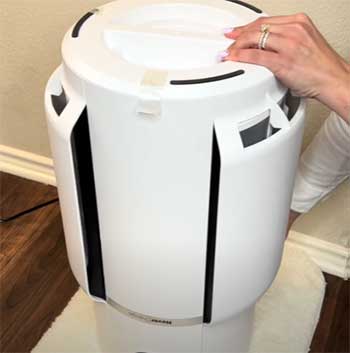
Coverage is key for effectiveness.
AirDoctor models like the AD3500 handle up to 1,260 square feet at two air changes per hour, ideal for open-plan living.
Shark’s MAX covers 1,000 square feet solidly, with strong CADR ratings that keep pace in most scenarios.
In my experience, both perform well in medium rooms, but AirDoctor’s multiple air exchanges make it feel more thorough in larger or busier spaces.
Shark’s auto-sensing adapts quickly to changes, like when I open windows. If your home is compact, either works; for bigger areas, factor in how often you want full cycles.
- Noise and Energy Use
Nobody wants a purifier that drowns out conversations. Both are quiet on low—around 30 dB—but AirDoctor can hit 59 dB on high, while Shark stays under 55 dB. I prefer Shark for bedrooms because of this.
Energy-wise, AirDoctor is more efficient, sipping power even on auto mode. Shark uses a bit more, especially with extras like heaters, but it’s not a bill-killer. If sustainability is your thing, AirDoctor might align better with your values.
- Cost and Maintenance
Upfront, Shark is friendlier to your wallet, starting lower and with that long filter promise. AirDoctor costs more initially and requires semi-annual changes, potentially adding up over time.
But consider value: If AirDoctor’s superior filtration prevents health issues, it might save money long-term. I’ve crunched numbers—Shark could cut filter expenses by 50% or more. Weigh your usage; heavy polluters might find Shark’s claim optimistic.
Key Features of The AirDoctor Air Purifier
When I unboxed my AirDoctor, the first thing that struck me was its straightforward design—nothing flashy, but built to perform. The core of its appeal lies in the UltraHEPA filter, which goes beyond standard HEPA by capturing particles as tiny as 0.003 microns.
That’s impressive because most allergens and viruses fall into that ultra-fine category. Paired with a pre-filter for larger debris and a carbon layer for VOCs and gases, it creates a multi-stage system that feels comprehensive.

- Advanced Filtration System: The multi-stage setup starts with a pre-filter that traps bigger particles like hair and dust, extending the life of the inner layers. Then comes the carbon filter, which absorbs volatile organic compounds from paints or cleaning products, and finally the UltraHEPA that snags microscopic threats. In my home, this combo has made a noticeable difference in reducing sneezes from floating allergens.
- Smart Air Quality Monitoring: One feature I appreciate is the air quality sensor that adjusts fan speeds automatically. On days when pollen counts spike, it ramps up without me lifting a finger. Some models, like the AD3500i, even connect to an app where I can monitor PM levels and set schedules, giving me control from my phone whether I’m at home or away.
- Optional Ionizer and Portability: The ionizer option adds an extra layer for neutralizing odors, though I turn it off in bedrooms to avoid any ozone concerns. Coverage-wise, it’s solid for medium to large rooms, circulating air multiple times hourly to keep things fresh. From a user standpoint, the wheels on larger models make it easy to move around, and the energy draw is minimal—I barely notice it on my electric bill. If you’re someone like me who values precision in air cleaning, this setup delivers without unnecessary bells and whistles.
Pros of The AirDoctor Air Purifier
Let me tell you, the filtration prowess is a game-changer. In my tests at home, it cleared out cooking smells and pet hair allergens faster than expected, often within 15 minutes for a standard room.
The UltraHEPA tech means it’s catching stuff that slips through regular filters, which is crucial if you have asthma or sensitivities. I love how quiet it runs on lower settings—perfect for nighttime use without disturbing sleep.
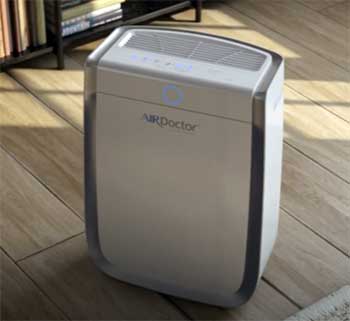
- Superior Particle Capture: The ability to trap ultra-fine particles down to 0.003 microns sets it apart, providing hospital-grade cleanliness that I’ve felt in reduced allergy symptoms during high-pollen seasons. This level of detail ensures even the tiniest pollutants don’t stand a chance.
- Quiet Operation and Energy Efficiency: Portability is another win; I can roll it from the living room to the office effortlessly. The app integration on connected models lets me check air quality remotely, which gives peace of mind when I’m out. Energy efficiency keeps costs down, and the build quality feels durable, like it’ll last through seasons of heavy use. For families or those in polluted areas, it’s a reliable ally against invisible threats. On the practical side, replacement filters are straightforward to swap, and the system alerts you when it’s time. I’ve found it effective against wildfire smoke too, based on my experiences during hazy summers.
- User-Friendly Design and Reliability: Overall, it feels like an investment in health rather than just another gadget, with features that adapt to real-life needs without overcomplicating things.
Cons of The AirDoctor Air Purifier
That said, no product is perfect, and AirDoctor has its drawbacks. The upfront cost is higher than many competitors, which might make you hesitate if you’re on a budget.
Filter replacements aren’t cheap either—expect to spend $100 or more every six months to a year, depending on usage. I’ve heard from other users about customer service being hit-or-miss; when I had a question about setup, the response took longer than ideal.
- Higher Initial and Maintenance Costs: The premium price tag can be a barrier, especially when factoring in recurring filter expenses that add up over time in dusty environments.
- Limited Accessories and Potential Noise: Some models lack a remote control, so you’re stuck using the top buttons or app, which isn’t always convenient. The ionizer, while helpful, can produce trace ozone, so I advise caution in small spaces. Longevity concerns pop up in reviews too—units might not hold up as well after a couple of years. If you need something ultra-quiet at max speed, it can get a bit noisy, though not overwhelmingly so.
- Service and Durability Issues: In my view, these issues are manageable if you prioritize top-tier filtration, but they could be deal-breakers for casual users seeking simplicity.
Also Read: Comparison of Blueair And AirDoctor Air Purifiers.
Key Features of The Shark Air Purifier
Switching gears to Shark, I was drawn to their NeverChange line because who doesn’t want a filter that lasts five years? The HP302 model, for instance, uses a True HEPA filter with NanoSeal to trap 99.97% of particles down to 0.3 microns.
It includes washable pre-filters on the sides that catch bigger stuff and an odor neutralizer cartridge for scents.
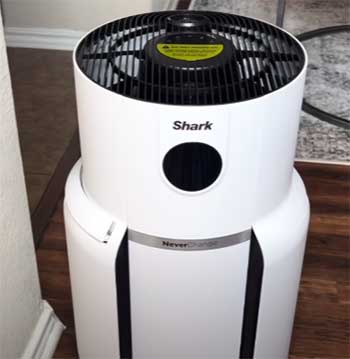
- Long-Lasting Filter Technology: The standout is the claimed five-year filter life, which minimizes replacements and keeps ongoing costs low, appealing to anyone tired of frequent maintenance.
- Intelligent Sensing and Display: The Clean Sense IQ is a standout— it monitors air quality in real-time and adjusts accordingly, displaying PM levels on the unit. Some versions, like the 3-in-1, add fan and heater modes, turning it into a versatile device. Coverage extends to larger spaces, and the design is compact enough for tabletops or floors. I like the auto-off timer and child lock for safety.
- Multi-Functional Options: From a hands-on perspective, it’s user-friendly with intuitive controls, and the long filter life means less maintenance hassle. If you’re looking for something that blends into your routine without constant attention, Shark nails that balance with added modes for heating or cooling air flow.
Pros of The Shark Air Purifier
The biggest advantage in my book is that extended filter lifespan—up to five years under normal conditions, which could save you hundreds compared to frequent replacements. It’s powerful yet quiet, handling large rooms without much noise, and the auto-adjust feature keeps things efficient.
I found it great for odors; the neutralizer tackles pet smells and kitchen fumes effectively.
- Cost Savings Over Time: The long-life filter translates to real savings, making it ideal for budget-minded households without sacrificing core performance.
- Effective Odor Control and Versatility: Multi-functionality in models like the 3-in-1 adds value—why buy separate heaters or fans? The PM display lets you see improvements in real-time, which is motivating. Price-wise, it’s more accessible, often under $400, making it appealing for first-time buyers. Build quality is solid, with a modern look that fits most decors.
- Everyday Reliability: In everyday use, it’s reliable for allergies and dust, and the washable filters are easy to clean. For budget-conscious folks who want performance without the premium tag, Shark delivers a lot of bang for your buck.
Cons of The Shark Air Purifier
On the flip side, the filter life claim might not hold up in high-pollution environments—I’ve seen reports of needing changes sooner. The HEPA standard is good but doesn’t match AirDoctor’s ultra-fine capture, so if you need the absolute best for viruses, it falls short.
Some users mention the odor cartridge running out quickly, adding to costs.
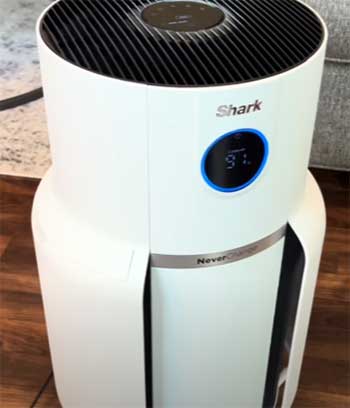
- Variable Filter Longevity: In dirtier settings, the five-year promise might shorten, leading to unexpected expenses.
- Standard Filtration Limitations: Noise at higher speeds can be noticeable, though not excessive. Customer support varies, and warranty claims might require persistence. The design, while functional, isn’t as portable as wheeled models from other brands. If you’re in a very dusty home, the pre-filters might need frequent washing, which adds upkeep.
- Maintenance and Support Concerns: Overall, these aren’t major flaws, but they highlight where Shark prioritizes convenience over cutting-edge tech.
When To Choose AirDoctor?
Picture this: You’re in a city apartment with traffic fumes seeping in, or you have severe allergies that demand the finest filtration. That’s where AirDoctor shines. I recommend it for health-focused users who want app monitoring and ultra-protection. Families with kids or elderly members benefit from its virus-trapping ability.
In my routine, it transformed my sleep during pollen season—no more waking up congested. If quality over quantity matters, go AirDoctor.
When To Choose Shark?
Now, if you’re budget-savvy and need something low-maintenance for general use, Shark fits perfectly. Great for pet owners battling odors or those in larger homes wanting auto-features without fuss. The multi-mode options add versatility for year-round comfort.
I’ve seen it work wonders in friends’ homes with kids and dogs—easy to operate, effective without constant tweaks. For everyday freshness on a dime, Shark is your pick.
Also Read: Comparison of Bluonics And RainMate Air Purifiers.
Frequently Asked Questions (FAQ)
It stands out for ultra-fine particle capture, but depends on your needs compared to brands like Coway or Levoit.
Coway Airmega often tops lists for balance of performance and price.
Yes, especially for long filter life and odor control in everyday use.
It varies; Dyson for innovation, Honeywell for affordability, but AirDoctor and Shark excel in specific areas.
Wrapping UP
Ultimately, if top filtration is key, pick AirDoctor. For value and simplicity, Shark.
In conclusion, I’ve shared my journey comparing these two to help you breathe easier. You might lean toward AirDoctor if health precision matters most, or Shark if practicality wins. Whichever you choose, cleaner air awaits—take that step for your well-being.
